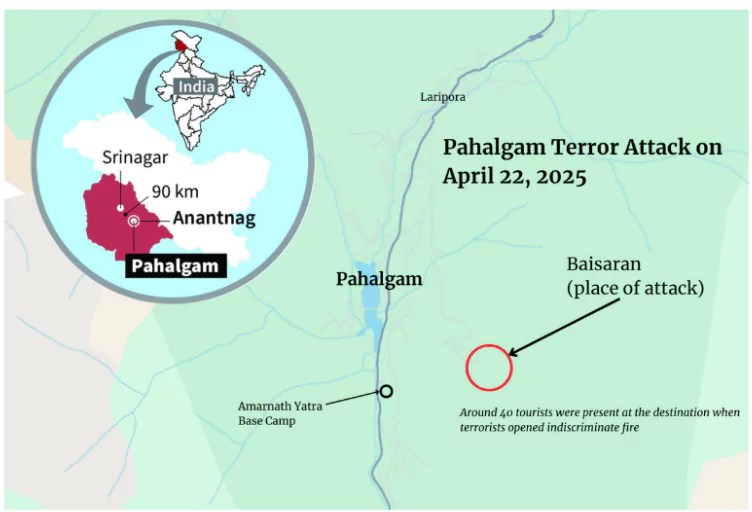Recently, many tourists were killed in a terrorist attack in Pahalgam, J&K.

About Terrorism
- The term “terrorism” originated from the Reign of Terror (Regime de la Terreur) of 1793-94.
Definition of Terrorism
- There is no universally accepted legal definition of terrorism.
Comprehensive Convention on International Terrorism (CCIT):
- In 1996, India proposed the adoption of the Comprehensive Convention on International Terrorism (CCIT) to the United Nations General Assembly (UNGA).
- It is a proposed treaty which intends to criminalise all forms of international terrorism and deny terrorists, their financiers and supporters access to funds, arms, and safe havens.
- It is yet to be adopted by the UNGA.
|
- United Nations Crime Branch: The short legal definition proposed by Schmid to the United Nations Crime Branch (1992) is that Act of Terrorism = Peacetime Equivalent of War Crime.
- League of Nations Convention (1937): Describes terrorism as “all criminal acts directed against a State and intended or calculated to create a state of terror in the minds of particular persons or a group of persons or the general public”. .
Position in India
- No IPC Provision: Terrorism is not explicitly defined in the Indian Penal Code, 1860.
- The first specific law was the Terrorist and Disruptive Activities (Prevention) Act (TADA), 1987, followed by POTA (2002), which was repealed in 2004. The Unlawful Activities (Prevention) Act (UAPA), 1967 was amended in 2004 and 2019 to define terrorist acts.
- Definition under UAPA: A terrorist act includes any action done with intent to threaten the unity, integrity, security, or sovereignty of India by means such as bombs, firearms, chemicals, or biological weapons that cause death, injury, or destruction.
- Comprehensive Convention on International Terrorism (CCIT) Definition: Terrorism includes actions that:
- Cause death or serious injury.
- Result in significant damage to property, including public infrastructure.
- Intend to intimidate populations or coerce governments or international organisations.
- Bharatiya Nyaya Sanhita (BNS, 2023): Defined under Section 113 as any act done with the intent to threaten the unity, integrity, sovereignty, security, or economic security of India, or to strike terror in the people.
- This includes acts like using explosives, firearms, or other hazardous substances to cause death, injury, property damage, or disruption of essential services.
- Indian Legal Focus: Unlike Western definitions, Indian law does not emphasize the ideological or religious motives behind terrorism.
- The focus is more on the nature of the act and its impact rather than the underlying intent.
Why No Universal Definition of Terrorism?
- Disagreement Over State-Sponsored Terrorism: Many countries, especially those accused of sponsoring or supporting terrorism (like Pakistan), resist definitions that might implicate their own state agencies or proxies.
- Confusion Between Terrorism and Freedom Struggles: Several countries argue that violent resistance against foreign occupation or for self-determination (e.g., Palestinian cause) should not be labeled as terrorism.
- This leads to a deadlock in UN negotiations, especially regarding the proposed Comprehensive Convention on International Terrorism (CCIT).
|
Terrorism-Affected Regions
- Jammu & Kashmir: Frequent attacks by Pakistan-based terror outfits like LeT, JeM, and TRF.
- Targets include civilians, security forces, and infrastructure—backed by cross-border infiltration.
- North-East India: Ethno-nationalist insurgencies by groups like ULFA and NSCN demand autonomy or secession.
- Militancy stems from ethnic identity, economic neglect, and border complexities.
- Central India (Red Corridor): Affected by Maoist (Naxalite) violence seeking to overthrow the democratic state through armed revolution.
- Strongholds include Chhattisgarh, Jharkhand, Odisha, and parts of Maharashtra and Andhra Pradesh.
- Urban India (Hinterland): Major cities like Delhi and Mumbai have faced coordinated bomb blasts by Indian Mujahideen and SIMI.
- Attacks aim to create panic and highlight sleeper cell activity within urban areas.
- Punjab (historical): Witnessed Khalistani separatist terrorism during the 1980s–90s, now largely under control.
- Occasional revival attempts are made via foreign propaganda and funding.
Types of Terrorism
- Ethno-Nationalist Terrorism: Violence by subnational ethnic groups seeking either a separate state or dominance; e.g., Tamil Tigers in Sri Lanka, insurgents in NE India.
- Religious Terrorism: Motivated by the belief that violence is a divine duty or sacred obligation; e.g., Al-Qaeda, Islamic State, TRF.
- Ideology-Oriented Terrorism: Violence rooted in political ideologies:
- Left-Wing: Aimed at overthrowing capitalist systems; e.g., Maoists in India, Red Brigades (Italy).
- Right-Wing: Aimed at preserving traditional order or nationalism; e.g., Ku Klux Klan (USA), Nazi militias.
- State-Sponsored Terrorism: Terrorism supported by governments as a tool of foreign policy; e.g., Pakistan’s ISI support to terror groups in India.
- Narco-Terrorism: Terror funded or supported by drug trafficking; e.g., FARC (Colombia), IMU (Uzbekistan), ISI-backed networks in Kashmir.
|
Reasons for Terrorism in India
- State-Sponsored Terrorism (Especially from Pakistan): Pakistan uses terrorism as a tool of foreign policy via proxy groups like LeT and JeM.
- The 2019 Pulwama attack was orchestrated by a Pakistan-based suicide bomber; ISI funds terror through fake currency, charities like Al-Rashid, and drug money.
- Ideological Extremism (Left-wing and Right-wing): Extremist ideologies justify violence to achieve political or social change.
- Left-Wing Extremism (LWE) remains active in Chhattisgarh and Jharkhand.
- Separatist and Ethno-Nationalist Movements: Some regions seek secession or autonomy due to identity-based grievances.
- Khalistan movement (1980s–90s) and renewed efforts from diaspora groups; Northeast insurgent outfits seek ethnic identity recognition.
- Radicalisation and Online Propaganda: Terror groups use social media to spread extremist ideologies and recruit youth.
- In February 2024, four youth were arrested for being radicalized through online means including honey-trapping and social media propaganda.
- Organized Crime and Narco-Terrorism: Terrorist groups fund operations through criminal activities like drug trafficking.
- High youth unemployment: High youth unemployment, marked by economic instability, increases susceptibility to terrorist recruitment, which offers a sense of purpose and financial gain.
- Poverty and Illiteracy: Poverty and illiteracy create conditions of vulnerability, making individuals more susceptible to extremist propaganda and violence as a means of addressing grievances.
- Technological and Global Influences: Globalisation and tech access have expanded terror reach through digital communication and logistics.
- Terrorists use encrypted apps and internet platforms to coordinate attacks and share propaganda; international support helps revive groups like TRF.
Key Terrorist Groups in India
- Pakistan-Based Groups (Active in J&K)
- Lashkar-e-Taiba (LeT): Pakistan-backed; responsible for 26/11 Mumbai attacks (2008) and other major strikes.
- Uses proxies like The Resistance Front (TRF) to project attacks as “indigenous.”
- The Resistance Front (TRF): LeT’s shadow outfit, formed post-Article 370 abrogation (2019).
- The MHA banned the outfit under the Unlawful Activities (Prevention) Act (UAPA) in 2023.
- Claims attacks (e.g., 2025 Pahalgam tourist massacre) to disrupt Kashmir’s economy.
- Uses social media propaganda and encrypted tech.
- Jaish-e-Mohammed (JeM): Behind 2001 Parliament attack and 2019 Pulwama suicide bombing.
- Linked to Pakistan’s ISI; focuses on high-profile military/civilian targets.
- Hizbul Mujahideen: Kashmir-centric; blends local recruitment with Pak support.
- Indigenous Groups
- Indian Mujahideen (IM): Offshoot of SIMI (Students’ Islamic Movement of India); targets urban centers (e.g., 2013 Hyderabad blasts).
- Popular Front of India (PFI): Banned in 2022 for alleged terror links and radicalization.
- Left-Wing Extremists
- CPI-Maoist: Operates in “Red Corridor” (Chhattisgarh, Jharkhand).
- Funds via extortion, mining taxes.
- Islamic State Affiliates
- ISIS-Khorasan (IS-K): Recruits via dark web; uses crypto (Monero) for funding.
- Al-Hind module of ISIS: Linked to Bengaluru café blast (2024).
- Northeast Insurgents: ULFA, NSCN
- Seek secession; exploit porous borders with Myanmar.
Key Terror Incidents
- 9/11 Attacks on the United States (2001): Al-Qaeda hijacked four planes on September 11, 2001, targeting the World Trade Center,killing nearly 3,000 people.
- This attack prompted the U.S. to launch the War on Terror, a global military campaign against terrorism.
- 26/11 Mumbai Attacks, India(2008): Lashkar-e-Taiba (LeT) militants carried out coordinated attacks on multiple locations in Mumbai, killing 166 and injuring over 300.
- Nice Truck Attack in France (2016): During Bastille Day celebrations, a truck driven by an attacker drove through crowds, killing 86 people and injuring hundreds.
- Beheading of Samuel Paty (2020): A French school teacher was killed for showing caricatures of the Prophet Muhammad in a classroom discussion on freedom of expression.
- Sparked national debates on secularism, free speech, and anti-radicalisation strategies in France.
|
Initiatives Taken To Combat Terrorism In India
- ‘Zero Tolerance Policy’ Against Terrorism: The Government upholds a firm zero tolerance approach toward terrorism, reflecting a commitment to completely eradicating terror activities and their support networks.
- National Investigation Agency (NIA): It functions as the Central Counter Terrorism Law Enforcement Agency in India.
- Establishment: It was established through the National Investigation Agency Act, 2008, following the 26/11 Mumbai terror attacks.
- Increase in the jurisdiction of NIA: The jurisdiction of the NIA has been increased by amending the NIA Act and now it can probe terror cases abroad too.
- Establishment of National Intelligence Grid (NATGRID): It is an integrated database for counter-terrorism, connecting the databases of 21 core security agencies in India.
- It enables round-the-clock access to comprehensive intelligence patterns for security agencies.
- Amendment of UAPA: By amending the UAPA, authorities now have the power to confiscate properties and declare organisations and individuals as terrorists.
- Preparation Of 25-Point Integrated Plan: 25-Point Integrated Plan has been prepared to stop the funding of terrorism, including Jihadi terror and Left Wing Extremism.
- Scope of Multi Agency Centre (MAC) was expanded: Scope of Multi Agency Centre (MAC), an intelligence gathering mechanism, was expanded.
- Established post-Kargil, this IB-led grid enables 24/7 intelligence coordination across central and state agencies.
- National-Level Terror Database
- National Automated Fingerprint Identification System (NAFIS): Holds over 90 lakh fingerprint records to enhance identification and tracking of terror suspects.
- Integrated Monitoring of Terrorism (IMT): Contains data on 22,000 terrorist cases, aiding in the monitoring and analysis of terror-related activities.
- National Integrated Database on Arrested Narco-Offenders: Tracks over 5 lakh offenders involved in narco-terrorism to counter the nexus between drugs and terrorism.
- National Database of Human Trafficking Offenders: Maintains data on approximately 1 lakh human traffickers, supporting efforts to combat human trafficking linked to terror activities.
- Others:
-
- Terror Funding and Fake Currency (TFFC) Cell: A cell has been constituted in the National Investigation Agency (NIA) to conduct a focused investigation of terror funding and fake currency cases.
- Coordination Group: FICN Coordination Group (FCORD) has been formed by the Ministry of Home Affairs to share intelligence/information among the security agencies of the states/centres to counter the problem of circulation of fake currency notes.
International Initiatives to Counter Terrorism
- UN Global Counter-Terrorism Strategy: The UN General Assembly adopted by consensus the UN Global Counter-Terrorism Strategy on 8 September 2006.
- The strategy is a unique global instrument to enhance national, regional and international efforts to counter terrorism.
- The General Assembly reviews the Strategy every two years, making it a living document attuned to Member States’ counter-terrorism priorities.
- United Nations Office of Counter-Terrorism (UNOCT): promotes international cooperation in the fight against terrorism and supports the Member States in implementing the Global Counter-Terrorism Strategy.
- SAARC Convention on the Suppression of Terrorism (1987): A regional agreement among South Asian nations to promote cooperation in combating terrorism and extraditing terrorists within the region.
- Financial Action Task Force (FATF): The FATF works to combat money laundering and terrorist financing by setting global standards and ensuring compliance by countries through regular evaluations.
- INTERPOL: Facilitates global police cooperation and the exchange of information to fight transnational terrorism, with its secure communication systems enabling swift data sharing among member countries.
- United Nations Security Council (UNSC) 1267 committee: It was set up under UNSC Resolution 1267 in 1999 (updated in 2011 and 2015) allows any UN member state to propose adding the name of a terrorist or terror group to a consolidated list.
- Arab Convention on the Suppression of Terrorism: It was signed at meeting held at the General Secretariat of the League of Arab States in Cairo on 22 April 1998.
- The Organisation of African Unity (OAU) Convention on the Prevention and Combating of Terrorism: It was adopted at Algiers in 1999. It entered into force in 2002.
|
Challenges in Combating Terrorism in India
- Porous Borders and Geographical Vulnerability: India shares long and porous borders with Pakistan, Nepal, Myanmar, and Bangladesh, which facilitate infiltration.
- Maritime borders, especially the western coast, have also been exploited (e.g., 26/11 Mumbai attacks).
- Organised Crime and Narco-Terrorism: Terrorists increasingly partner with criminal syndicates for weapons, logistics, and safe havens.
- Drug and arms smuggling across borders in Punjab and J&K funds terrorism.
- Use of Advanced Technology: Terrorists exploit encrypted apps, VPNs, and drones, making surveillance and tracking difficult.
- Drone attacks like the 2021 Jammu Air Force Station bombing highlight these threats.
- Cross-Border Terrorism and State Sponsorship: Terror groups like LeT and JeM receive backing from Pakistan’s ISI to infiltrate Indian territory.
- The 2019 Pulwama attack was carried out by a Pakistan-based suicide bomber.
- Radicalisation via Social Media: Terrorist propaganda on platforms like Twitter, Telegram, and Instagram has radicalized Indian youth.
- In Feb 2024, NIA arrested 4 individuals radicalized online, including via honey-trapping.
- Inadequate Coordination Among Agencies: Lack of seamless information sharing between state and central forces weakens rapid response.
- Despite MAC’s role, coordination lapses still exist, affecting field operations.
- Legal and Structural Hurdles: Federal complexities hinder uniform counter-terror frameworks; misuse of laws breeds mistrust.
- Delay in setting up the National Counterterrorism Center and misuse concerns in laws like TADA and POTA led to their repeal.
- Terror Financing: Inadequate monitoring of hawala transactions, misuse of charities, and NGOs.
- India has improved compliance with FATF norms, but enforcement remains uneven.
- Emerging Cyber and Bioterror Threats: Terrorists could weaponize biological agents or critical data systems.
- India’s immigration database was breached by a Chinese firm—highlighting cyber vulnerability.
Way Forward for Combating Terrorism in India
- Strengthen Intelligence Coordination: Enhance real-time data sharing across agencies like MAC, NIA, and State Police.
- Operationalize NATGRID fully and integrate it with AI-based threat analysis.
- Regulate and Monitor Digital Platforms: Curb online radicalization by tracking encrypted channels and social media handles.
- Set up a cyber command center to monitor and act against digital terror content.
- Target Terror Financing Ecosystem: Block narco-terrorism, hawala, and misuse of NGOs through robust financial surveillance.
- Expand FIU’s role and audit foreign-funded NGOs under FCRA guidelines.
- Boost Capacity of Police and Security Forces: Invest in counter-terror training, weapons, and technology at the state level.
- Create Special Counter-Terror Units in every major state on the NIA model.
- Balance Security with Civil Liberties: Avoid misuse of laws like UAPA to prevent alienation and uphold democratic values.
- Ensure judicial oversight and periodic review of arrests under anti-terror laws.
- De-radicalization and Community Outreach: Promote education, employment, and inclusive governance to undercut extremist influence.
- Implement rehabilitation schemes for misguided youth and involve community leaders.
- International Cooperation and Border Management: Collaborate globally through FATF, INTERPOL, and bilateral ties to track cross-border threats.
- Strengthen border surveillance with drones and high-tech fencing, especially on western front.
Conclusion
Terrorism in India, driven by diverse factors like state-sponsored groups, ideological extremism, and socio-economic vulnerabilities, poses a significant threat to national security. By balancing security with civil liberties and addressing root causes like poverty and radicalization, India can effectively combat this multifaceted challenge.
![]() 23 Apr 2025
23 Apr 2025


